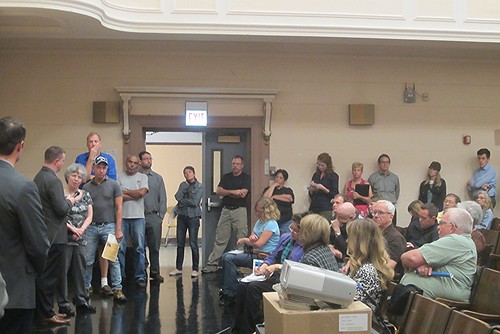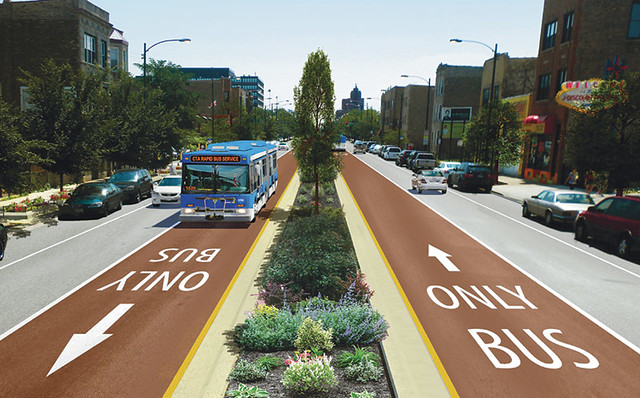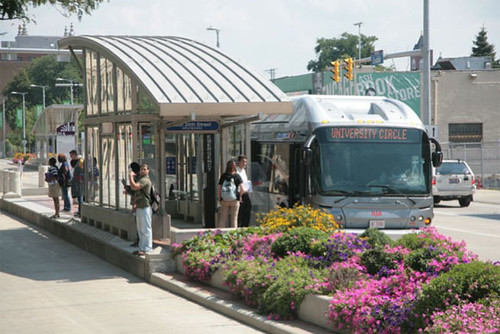Bus rapid transit opponents may have made the most noise at Tuesday night’s community meeting about the CTA’s plan for fast, reliable bus service on Ashland Avenue, hosted by the Chicago Grand Neighbors Association at Talcott Elementary School in Noble Square. But when you’re familiar with the details of the proposal, as well as successful BRT and bus-priority routes in other cities, it becomes clear that the NIMBY arguments don't hold water.
CTA Manager of Strategic Planning Joe Iacobucci outlined the plan to speed buses to 15.9 mph during rush hour by implementing dedicated, center-running bus lanes, prepaid, level boarding on buses with multiple doors, traffic signal prioritization, and other timesaving features. As part of the project, two of the four car lanes would be converted to bus lanes and most left turns would be prohibited.
CGNA President Lyn Wolfson had opened the meeting by saying, "Transportation is a major factor in quality of life," but audience members who angrily grilled Iacobucci about the lane conversions and turn prohibitions during the Q & A session appeared less interested in how BRT will improve quality of life on the Ashland corridor than its impact on their driving habits. They didn’t seem to pay attention when Iacobucci shared examples of how other cities have used BRT to create safer and more livable streets, improve commutes, and boost the local economy.
It’s understandable that people are concerned about a change as significant as BRT on Ashland, but once you look at the very real benefits of prioritizing transit on city streets, there's little to fear. The CTA predicts bus ridership on Ashland will increase by 30 percent. The experience of BRT in Cleveland, where the new Health Line route led to a 60 percent ridership increase in a few short years, suggests that there might be room for even more growth in Chicago.
At last week's BRT roundtable hosted by Metropolitan Planning Council, staff from the Institute for Transportation and Development Policy discussed how BRT is a strong economic development tool, since benefits like faster bus service, calmer traffic, and more walkable streets can unlock the value of nearby land. They also pointed out how Chicago’s grid system makes the city an ideal place for BRT, since motorists can easily choose alternative routes to Ashland, and drivers on Ashland who need to go left can simply make three right turns to do so.
Local residents and CGNA members Nora Beck and Lindsay Bayley, a Streetsblog contributor, raised similar points Tuesday night when stating their support for BRT during the Q & A. In her comments, Beck also noted that good public transit was one of the main things that attracted her to Chicago in the first place. “I realized I didn’t need to buy a car," she said. "That’s one of the reasons why I live here still.”
When Iacobucci explained the CTA's design and site selection process to residents, the quality of life and economic advantages of BRT didn’t seem to register with some people in the audience. Accusations were hurled about CTA staffers being out of touch with community member’s needs, but a glance at other cities suggests that bus lanes are a better fit for urban neighborhoods than streets designed primarily for cars. After New York City's Select Bus Service debuted along Fordham Road in the Bronx, for instance, retail sales at local stores increased by 71 percent -- three times higher than the Bronx as a whole.
Despite attendee Dan Ryan’s claim that Iacobucci “raced through” statistics during his presentation, the CTA staffer’s talk was full of useful info for people curious about the project. He showed how BRT is a cost-effective form of transit when done right, and has generated big returns on investment. BRT costs about a third as much as light rail, and the Cleveland HealthLine, which involved an initial $200 million investment, helped spur $4.3 billion in real estate development on the Euclid Avenue corridor.
Once BRT is up and running, possibly as early as late 2015 for the first 5.4-mile stretch between 31st Street and Cortland Street, depending on the availability of federal funding, it will be the logical choice for speedy travel on Ashland without the expense and headaches of driving. The service will be 83 percent faster than the current buses, and it will offer seamless connections to other transit lines, as well as employment, education and entertainment destinations like the Illinois Medical Campus, UIC and the United Center. Just as there were plenty of naysayers when Divvy bike-share was introduced who changed their tune when the system turned out to be hugely successful, after the Ashland BRT launches and people start reaping the benefits, folks will wonder why we didn’t do this sooner.
Guest contributor Kristen Maddox recently spent a year in Copenhagen as a Fulbright fellow and worked with Copenhagenize Design Company.







